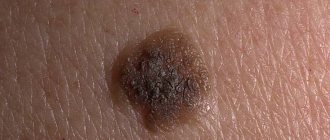What are warts
Warts are rounded elevations of the skin in the form of a papilla or nodule with clear contours and a dense structure, arising due to the active growth of the upper layers of the epithelium. They can appear in absolutely every person, at any age and on any part of the skin, from the head to the soles of the feet. The most common “targets” are exposed areas of the body that are often subject to injury: arms, elbows, knees, head. Warts can reach sizes from 1 mm to 15 mm: this directly depends on its type and location of formation. They are located on the body singly or in small groups, and their distribution depends on the functioning of the immune system. There is also a rapid increase in the number of growths when the integrity of the wart is damaged. Sometimes several warts merge, forming a large tumor with a wide base in the form of a cone or hemisphere. When they appear, the growths are flesh-colored, and over time they can acquire a brown or even black tint, sometimes gray or yellowish. Their surface can be smooth, slightly rough or pimply. Outwardly, they resemble acne or calluses, so they are quite easy to confuse. A feature of warts is the high probability of spontaneous remission, especially if they arose in childhood.
What are papillomas
Papillomas are also benign formations. They come in a variety of shapes - leaf-shaped, spherical, filamentous or lobed, often resembling cauliflower in appearance. The growths have a soft, loose structure and are located on a thin stalk. Initially, their size is about 2 mm, but gradually they are able to grow up to 1-2 cm. The color of papillomas also varies from white to dark brown. The favorite location is areas of the body with thin and delicate skin, folds and mucous membranes, i.e. these are the neck, eyelids, nasolabial fold, armpits, area under the mammary glands, genitals, groin area, perianal fold, around the anus, in the rectum, urethra, bladder, etc. Quite rarely, papillomas can form in the oral cavity and on the vocal cords. The growth can be either single or multiple. Basically, there are 5-20 papillomas in one area. Their prevalence largely depends on the immune system and its ability to resist the virus. The main feature of this type of neoplasm is the increased threat of transition to a malignant form. This is especially true for papillomas that form on the mucous membranes of the female genital organs. If left untreated, they cause cancer.
How not to confuse a wart with a papilloma
Despite the differences, these two neoplasms are often confused with each other. To identify them, it is first necessary to carefully examine the growth. In medicine, this technique is called dermatoscopy. It is carried out using a magnifying glass or dermatoscope. However, even without special instruments it is possible to determine what shape, size and color the growth has. The first two parameters differ between them.
The same indirect sign is the localization of the pathological process. If delicate tissues or mucous membranes are affected, then it is a papilloma, more coarse ones - a wart .
More precisely, we can say only after a biopsy of the material under study and microscopy of the smear. The presence of vacuoles in the histological picture indicates that the biopsy was taken from a wart; the absence of vacuoles, but columnar or non-keratinizing epithelium indicates a papilloma.
Photo 2. The appearance of papillomas or warts in any case requires consultation with a doctor. Source: Flickr (lifoot care)
Causes of warts and papillomas
The appearance of warts and papillomas is a consequence of the human papillomavirus (HPV) entering the body. And the well-known theory that warts appear from touching a frog is just a misconception. You can become infected with papillomavirus in several ways:
- sexually;
- during childbirth;
- contact and household.
- Speaking in more detail about the household contact method, we can highlight the following ways of infection entering the body:
- direct skin contact (handshake, kiss);
- through objects of common use (in the gym, in transport);
- when using personal items (razor, toothbrush);
- wearing someone else's shoes, walking barefoot in public places (baths, swimming pools, etc.);
- when carrying out cosmetic procedures with instruments that have not been disinfected (epilation, manicure).
The virus penetrates through microcracks, cuts or abrasions on the skin. After penetration, the pathogen goes into standby mode and is activated under certain conditions. That is why there is no exact definition of the incubation period of HPV. In people with a strong immune system, neoplasms do not form; the pathogen is destroyed and eliminated from the body within a year. The following factors can “activate” the virus and thereby cause the growth of warts and papillomas:
- infectious diseases that weaken the immune system;
- stressful situations and nervous overstrain;
- pregnancy;
- obesity;
- decreased immunity;
- undergoing chemotherapy;
- avitaminosis;
- diabetes;
- hormonal imbalance;
- heavy and prolonged physical activity;
- lack of hygiene;
- bad habits;
- diseases of the gastrointestinal tract;
- long-term use of antibiotics that suppress the immune system.
Older people and children are most likely to become infected with the virus. This is due to the condition of the skin in this age category. Genetic predisposition also influences HPV susceptibility to some extent.
Features of moles
Benign formations on the human skin, which are formed by pigment cells, are called moles or nevi. Moles most often appear in infants and continue to form throughout life. The intensity of their manifestations can have varying degrees.
Nevi themselves are not dangerous, but sometimes in the event of injury, moles have a strong relationship with the subsequent development of the oncological process. Active growth of nevi is often observed during puberty and pregnancy, since at this time hormonal levels change greatly.
Moles and papillomas do not always remain benign tumors and can lead to serious complications, so it is necessary to constantly monitor such neoplasms to prevent their degeneration.
Differences and similarities between warts and papillomas
It is often difficult to distinguish a wart from a papilloma, since they are very similar to each other. In some cases, it is difficult even for a dermatologist to do this during a visual examination. Warts and papillomas have the following common features:
- formation on the surface of the epithelium;
- the nature of the neoplasms is viral: they develop due to the entry of the human papillomavirus into the body;
- the initial character is benign;
- under certain conditions they can become malignant;
- may cause itching, irritation, swelling of nearby tissues;
- have blood vessels, so they bleed when injured;
- education and development are affected by the state of the immune system;
- After removal there is a risk of relapse.
Types of skin neoplasms
Before you understand how to distinguish a mole from a papilloma, you should understand what types of skin tumors there are. Papillomas are divided into the following types based on appearance and location:
- Wart. A benign skin neoplasm, predominantly of viral origin, in the form of a nodule or papilla. In addition, they are divided into pointed, flat, simple or plantar.
- Condyloma. Warty formations on the skin and mucous membranes caused by the human papillomavirus. Externally, genital warts resemble a cauliflower inflorescence and are located mainly in the genital area or near the rectal sphincter.
- Acrochordon. This skin neoplasm is a soft, pedunculated polyp. Most often they can be found in the groin folds or axillary area, on the eyelids or neck.
- Horny keratoma. A dense formation of a spinous layer of skin, resembling a small horn in appearance.
Papillomas can be flat or hanging in shape and range in size from 2 to 15 mm in diameter.
Moles can also be very diverse:
- border;
- intradermal;
- intradermal;
- basal;
- linear;
- blue;
- Seton's nevus;
- Ota moles.
Many patients attribute any new growth on the skin to moles, but in reality this is far from the case. Only a dermatologist can determine for sure what growths on the skin are.
Despite many similarities, neoplasms have an impressive list of differences
| Index | Warts | Papillomas |
| Form | Mostly round with clear contours | Mostly leaf-shaped or lobed with fuzzy, ragged contours, looks like cauliflower |
| Color | From flesh to light brown, sometimes pink, can even acquire a black tint due to the accumulation of dirt | White to dark brown |
| Localization | On open areas of the body: arms, legs, scalp, etc. | In folds and mucous membranes: armpits, genitals, neck, face, etc. |
| Structure | Dense | Soft |
| Fastening | Wide base | "Leg" |
| Size | Capable of shrinking and growing | Only increasing |
| Peculiarity | Capable of self-destruction without treatment | Do not disappear on their own, must be removed |
| Treatment | Removal, possibly drug treatment | Delete only |
| Tendency to malignancy | Almost never reborn | High probability of transition |
Features of the treatment of each type of growth
These benign formations are treated according to the same scheme . The only difference is that untreated warts can disappear on their own, but papillomas do not. Therefore, the latter type of growth must always be removed, and the first - if necessary. Therapy for these tumors is divided into two sections: conservative treatment and surgical intervention.
To get rid of HPV, antiviral and immunomodulatory drugs are prescribed. They can be taken for both diseases. Specific drugs, doses and frequency of administration depend on the severity of the process.
Surgery consists of removing the changed tissue. It is produced using a scalpel, laser, cryodestruction and electrocoagulation. The removal method should be suggested by the doctor himself.
Types of warts
Today there are over 100 types of HPV, each of which gives rise to a certain type of warts and papillomas. The incubation period is about 2-6 months, but it largely depends on the human immune system: a strong and healthy body easily fights the occurrence and proliferation of growths. The following types of warts are distinguished:
- ordinary (simple, vulgar);
- plantar (pinuses);
- flat (juvenile);
- senile (age-related keratomas).
Ordinary (simple, vulgar) - warts in the form of small dense dry nodules with an uneven and rough surface, variable sizes and a rounded shape. They do not cause itching, pain or discomfort. Simple warts reach from 3 to 10 mm in diameter. They are usually flesh-colored, sometimes pink, yellowish, or light brown. Due to the accumulation of contaminants in the porous surface, they can turn dirty gray. The favorite localization of simple warts is the back of the hands and fingers. Sometimes they are observed on the knees and elbows, rarely on the face and feet. After some time (it’s different for everyone), the tumor increases in size, and the skin in its place begins to peel off. The progression of the pathology is manifested by the formation of a large “mother” wart with a scattering of small ones around. When removed, small ones usually self-destruct over time. Plantar warts (spikes) are warts in the form of several fused nodules with a roll of keratinized skin around them. Inside the growths, many small black dots are visible - thrombosed capillaries. Plantar warts are round in shape, rise above the skin by 1-2 mm and can reach up to 2 cm in diameter. However, 75% of the tumor is located in the deep layers of the epithelium, so their main feature is inward growth. Outwardly, these warts resemble calluses, which is why they are often confused with each other. It's important to remember that, unlike a callus, a ring of dead skin forms around a wart. Spines are localized on the feet, rarely on the palms. Usually colored yellow or dark brown. This type of wart causes significant discomfort, itching and pain, aggravated by walking, and may even bleed. In 50% of cases it self-destructs without treatment, but this may take from 8 to 18 months. As the pathology progresses, the number and size of warts will increase, which may lead to the inability to walk due to unbearable pain. Flat (juvenile) - warts in the form of small flat papules with a smooth (sometimes scaly) surface, slightly raised above the surface of the skin. Traditionally it affects people aged 10 to 25 years. They are formed in multiple clusters or singly, which is quite rare. Usually the growths are flesh-colored, sometimes white, brown, yellowish or pink. They appear on the face, neck, knees, elbows, back, legs and arms (especially on the fingers and back of the hands), sometimes on the head of the penis. As a rule, they are painless and do not cause discomfort unless they are subjected to mechanical pressure or damage. Flat warts can suddenly disappear on their own just as they appeared, especially in childhood. But sometimes they are quite difficult to treat. Senile (seborrheic keratoses) are warts in the form of dark, flat, round or oval plaques that appear in old age. They reach a diameter of 0.2-3 cm, sometimes 4-6 cm. The pathogenesis is not clear, but their appearance is definitely not associated with HPV. Senile warts can affect any part of the body except the palms, soles of the feet, and mucous membranes. As a rule, they appear in multiple clusters (about 20 foci). Initially, they appear as small light brown spots or papules with clear contours. Over time, keratoses may retain their appearance and resemble freckles, or they may harden, forming a warty surface covered with easily removable thin crusts. In most cases, senile warts take on a mushroom shape and are dark brown or black in color. They develop very slowly, over decades, never degenerating into a malignant form. Typically, seborrheic keratoses are removed for aesthetic reasons or because they become itchy and irritating. If the growths, especially large and warty ones, are injured (rubbed against clothing, touched by something), they may bleed or become inflamed.
Common warts
The most common clinical form of HPV. At first they appear as dome-shaped papules, no larger than the head of a pin.
Then they begin to grow and at the same time darken, their surface becomes rough. Daughter warts form around the mother wart, and pain and burning are possible during this period.
Warts are located on the back of the hands and feet, in the chin area, on the eyelids, on the scalp, between the fingers, and on the soles.
Plantar warts are painful and prevent a person from walking. Low oncogenic risk.
Butcher's warts This type of wart looks like a cutaneous horn (long thread-like papules). As a rule, they are localized on the arms and fingers, and often occur at the site of cuts. Caused by HPV 2 and 7, it is a benign formation that is not prone to degeneration.
Types of papillomas
- The following types of papillomas are distinguished:
- filamentous (acrochords);
- anogenital.
Anogenital (genital condylomas) - papillomas in the form of flesh-colored or pale pink growths of an acute shape, prone to fusion. When rubbed, they become crimson and begin to bleed. Such growths reach 1-1.5 cm and in appearance they resemble cauliflower or cockscomb due to their lobed structure. They are usually transmitted sexually and have a specific localization: on the genitals, in the perineum, on the walls of the vagina, on the foreskin, scrotum and around the anus. Although with less frequency, even in the absence of anal sexual intercourse, they can even grow in the anus and urethra, causing bleeding and discomfort during bowel movements. If the virus enters the body through oral sex, then warts appear on the mucous membrane of the oral cavity, in the pharynx, on the vocal cords or trachea. Sometimes they can form in the armpits, under the mammary glands, and in children - in the nasolabial folds. Anogenital papillomas are quite dangerous for humans for many reasons, the main one of which is the high probability of degeneration into a malignant form. Being inside a woman's vagina, they cause itching and burning, pain in the lower abdomen, pain and discomfort during sexual intercourse, and after it - spotting. Therefore, regardless of position, shape and size, genital warts should always be removed. Filiform - neoplasms in the form of thin, long, racemose shoots. They are also called facial because they are usually localized on the face, especially the eyelids and nasolabial folds, and neck. Rarely they can occur on the legs, in the groin folds, under the mammary glands and in the armpits. Those. they appear in areas of delicate and thin skin, in folds characterized by high humidity. It mainly affects older people. The process of formation of a growth begins with the appearance of a small nodule; over time, the formation acquires an elongated oval shape or remains round on a thin stalk. Traditionally, thread-like growths are flesh-colored, which is why they often go unnoticed for a long time, but sometimes they become yellow, brown or pink. They grow about 0.5-1 cm, exceeding that is extremely rare. The risk of acrochords degenerating into a malignant form is minimal, but if they are injured, an inflammatory process may develop. This type of neoplasm does not self-destruct and is prone to spreading to other parts of the body and increasing in size and number. For most people, this causes psychological discomfort, emotional stress and decreased self-esteem. Therefore, a cosmetic defect is the main reason for removing filamentous growths.
Plantar papillomas
The causative agent is HPV-1 (deep form), HPV-2 (mosaic warts) and HPV-4 (minor lesions).
The process begins with the appearance of a small shiny lump, which acquires the characteristics of a typical papilloma, surrounded by a protruding rim.
Sometimes, around one papilloma, numerous daughter formations appear that resemble vesicles - mosaic warts.
Plantar papillomas can be painful and make walking difficult. The duration of their existence varies. In some cases, especially in children, spontaneous disappearance of any number of papillomas is possible.
This form of the disease is often confused with calluses that appear at pressure points on the fingers or between the fingers. Calluses, unlike papillomas, have a smooth surface with a skin pattern.
Why are neoplasms dangerous?
The main danger that warts and papillomas pose is the threat of degeneration into a malignant form. The degree of their danger depends on the type of papillomavirus:
- high (oncogenic) – 16, 18, 31, 33, 35, 39, 45, 52, 58, 59, 68;
- low (non-oncogenic) – 6, 11, 26, 41, 42, 50, 61, 73, 82, etc.;
- absent – 1, 2, 3, 4, 5.
There is a high probability of malignancy if warts and papillomas are constantly injured (rubbed against clothing, touched by something, etc.). In this case, infection with harmful bacteria may occur. To prevent the degeneration of a benign tumor into a malignant one, it is necessary to regularly visit a dermatologist and not hesitate to detect suspicious symptoms. Particularly dangerous are genital warts that affect the internal genital organs of a woman, since they can cause serious diseases: pseudo-erosion of the cervix, ectopia of the columnar epithelium, and cervical cancer. In addition, their presence is manifested by a number of unpleasant symptoms: burning and itching in the vagina, unpleasant odor, pain in the lower abdomen, pain and discharge of ichor during sexual intercourse. In men, the lack of treatment for papillomas leads to decreased libido, erectile dysfunction, and infertility. It can also provoke dangerous diseases: adenocarcinoma, anal cancer, diseases of the penis, oral cavity or larynx.
Many varieties are not dangerous, but ignoring the treatment of warts and papillomas will provoke an increase in their number. And the constant attack of the body by viruses will ultimately lead to a deterioration in the overall health of a person.
Similarity of growths
The growths have common features. The similarities are:
- One way of infection. They are transmitted in the same way from a sick person to a healthy one.
- Appearance. Despite the visual differences, both formations look like a growth that differs from the overall structure of the skin.
- Benign nature. Like papillomas, warts are caused by non-oncogenic strains of HPV.
- Symptoms appear after immune decline. In both cases of disease, the appearance of growths is preceded by a general malaise.
- Unpleasant consequences of damage. If the growth is damaged, regardless of its type, there is a high probability of bleeding, swelling, and inflammation.
- Risk of papillomatosis. A wart, like a papilloma, although the difference is significant, can affect an area of skin throughout the body. Develops with the increased influence of HPV on the human body.
- Contagiousness. Viral formations are the focus of accumulation of infectious cells. Direct contact with them contributes to the transmission of the disease.
- General methods of diagnosis and treatment. Therapy for HPV, regardless of the form that arises, consists of a complex effect on the body. Drug treatment with antiviral and immunostimulating agents and hardware removal of formations are necessary.
- Tendency to relapse. Incorrect treatment or incomplete removal leads to reappearance. They may not be removed from the skin if their root remains in the human skin tissue.
- Probability of spontaneous disappearance. In young people with a high degree of immune defense, self-healing is possible, which leads to complete disappearance.
- Papillomas, like warts, are not prone to cancerous degeneration.
To obtain accurate information about the type of formation and its distinctive characteristics, you need to consult a dermatologist. The doctor will conduct an examination, prescribe the necessary tests, and select the optimal treatment method.
The sooner a person seeks help from a specialist, the more successful the treatment process will be.
Modern medicine uses cauterization, freezing, and surgical excision to treat papillomas, condylomas (genital growths) and warts. Some can be removed at home using special ointments or traditional therapy recipes. There are no differences in the treatment of formations; treatment at home is universal, including the use of celandine, garlic, hydrogen peroxide, iodine, baked onions, and soda.
Diagnostics
It is extremely important to correctly determine the type of tumor, taking into account oncogenicity and external similarity. Initially, the doctor conducts a clinical examination of the growth, if located on the genital organs - gynecological in women, proctological and urological in men. This is not enough to make an accurate diagnosis. To establish a reliable clinical picture, it is recommended to conduct research at the cellular level using special diagnostic methods, namely:
- cytological examination of cell morphology - to identify DNA mutations;
- colposcopy - examination of the vulva, vagina and cervix using a special microscope - colposcope;
- biopsy - sampling of cells and tissues for the purpose of diagnosing the pathogen;
- histology - a type of biopsy - to determine a precancerous condition;
- polymerase chain reaction (PCR) techniques - to identify all types of virus;
- Digene test. It is the most reliable and informative diagnostic method: it accurately determines the presence and type of HPV, the level of oncogenicity, and the degree of concentration of the pathogen in the body.
Most often, the diagnosis is made based on the results of using several methods, since individually each of them is erroneous to a certain extent.
Doctors to contact regarding this issue
Denezhkina Natalya Nikolaevna
Reshanova Lyudmila Mikhailovna
Varfolomeeva Oksana Igorevna
Chaplitsky Evgeniy Aleksandrovich, urologist-andrologist, specialist
Diagnosis of papillomas and warts
Due to the fact that the differences between condylomas and other rashes are insignificant, only a diagnostic study helps to correctly determine the type of growth. This is the first thing that a doctor will offer to his patient who came to him for an appointment with questions about the nature of the tumor on the body. There are actually differences between a papilloma and a wart, but they are revealed only during laboratory examination of samples taken during a biopsy.
The following diagnostic methods help determine the type of benign rash on the body or face:
- PCR;
- Biopsy followed by examination of a tissue sample;
- Colposcopy (to examine the vaginal mucosa in women).
One of the most informative tests is a biopsy. It is mandatory. The sample taken is examined under a microscope. The specialist will be able to observe the changes occurring in the skin cells that are affected by the virus.
Diagnosis of papillomas and warts always includes cytological and histological examination. Sometimes a specialist needs not only a scraping from the surface of the tumor, but a whole piece of it. Taking the sample does not harm the patient's health. Therefore, he may not worry about this and calmly agree to a biopsy.
Before removing the growth, you need to make sure it is of good quality.
Methods for removing tumors
Treatment of warts and papillomas should only be performed under the guidance of a qualified specialist. There should be no self-medication, since the pathology will not only not be eliminated, but will also significantly worsen, and serious complications may arise. Under no circumstances should you resort to your grandmother’s methods of tying the growth with thread or sealing it with tape in order to deprive it of blood flow. This can only injure the neoplasm, which will inevitably lead to the appearance of new growths and increase the risk of malignancy. Treatment of warts can be carried out medicinally using the following drugs:
- Viferon;
- Salicylic and Oxolinic ointments;
- Clareol;
- Antipapillomas;
- Cryopharma;
- Panavir;
- Isoprinosine.
The main goal of therapy is to increase the patient’s immunity, so the doctor may prescribe Echinacea, Immunal, Eleutherococcus and Aloe extract, Ribomunil, Lykopid, Imudon, Anaferon, Actovegin, FiBSA, multivitamins and others.
However, the high infectivity and autoacculation of warts are arguments in favor of their removal. Papillomas can only be removed. Today, the most common methods for removing warts and papillomas are:
- cryodestruction - freezing with liquid nitrogen, after which after a while the growth disappears. It is characterized by the absence of pain and a small number of complications. Practically ineffective in the fight against genital warts;
- removal with a radio knife - cutting off not only the growth itself, but also the epithelium underneath it. The device does not come into contact with the tumor, but acts on it from a distance. The procedure is performed under local anesthesia and lasts no more than 30 minutes;
- laser removal - excision of the growth with a laser beam. During the procedure, healthy tissue is not affected, the blood vessels are sealed, which eliminates bleeding, inflammation and scarring. Removal is painless and quick;
- electrocoagulation – removal of tumors using alternating current. Rare relapses occur after this procedure;
- surgical method - indicated in the case of large and deep tumors. The procedure is performed under local anesthesia. It has significant disadvantages: it causes relapses, leaves scars and scars.
Removal with a radio knife is one of the most popular procedures. It involves cutting off the growth using high-frequency radio waves. The procedure has many advantages:
- does not require special training;
- carried out quickly and painlessly;
- guarantees the absence of side effects in the future if all doctor’s recommendations are followed (relapses, scars, etc.);
- is particularly accurate and efficient;
- does not damage healthy tissue;
- bloodless and safe removal: the radio knife makes a cut, cauterizes blood vessels and disinfects;
- fast healing;
- affordable cost of the procedure.
As a rule, medical procedures are complemented by the use of measures to strengthen the immune system and destroy the human papilloma virus.
Causes and symptoms of human papillomavirus
What is papilloma?
Human papillomavirus (HPV) causes changes in tissue growth patterns. It causes various skin diseases and mucous membrane lesions. Modern medicine identifies more than a hundred types of the virus.
Papilloma is a tumor, considered benign, that grows on the surface of the skin and looks like a small nipple. The size of papillomas can be from one to two cm. Places of occurrence: oral cavity, nose, pharynx, vocal cords; can form on the bladder and other places.
Depending on the type of virus, diseases also differ: warts are caused by human papillomavirus types 2 and 4, flat warts are caused by viruses of types 3 and 10, and genital warts are caused by types 6 and 11. Some types of virus (16, 18, 31, 33, 35) cause cervical dysplasia or a favorable background for the development of cervical cancer. The human papillomavirus is transmitted through contact and household routes, remaining in the skin and mucous membranes.
Human papillomavirus is divided into two groups - high and low risk. The low-risk group includes types of the virus (primarily 6 and 11) that cause genital warts. The high-risk group includes types 16, 18, 31, 33, 35 of the virus, which cause cervical dysplasia and increase the risk of cervical cancer.
Every year, millions of people with genital warts turn to doctors for help. But even more often, such a viral infection goes unnoticed, as it is asymptomatic.
Symptoms of human papillomavirus
Symptoms of human papillomavirus depend on the type of virus. Most often, the virus does not manifest itself in infected people, as it is controlled by the immune system.
Condylomas. Low-risk viruses manifest themselves with the appearance of genital warts. This symptom occurs in only 2% of infected people. Condylomas are an indicator of a weakened immune system of a carrier of the papilloma virus. Condylomas are localized mainly on the genitals, near the anus and in places of contact during sexual intercourse. From the moment of infection with the virus until the appearance of condylomas, weeks or years can pass.
Condylomas are warty growths that are pinkish or flesh-colored. Their size ranges from a millimeter to several centimeters. Condylomas can grow, turning over time into multi-layered formations (condyloma condyloma).
In men, the place of formation of condylomas is mainly the head of the penis, the crown of the glans, and the frenulum of the foreskin; Rashes may also appear around the anus. In women, condylomas appear on the labia, clitoris, external opening of the urethra, in the vagina or on the cervix.
Depending on the state of the immune system, condylomas can grow, remain unchanged for a long time, or disappear on their own. Condylomas are an extremely dangerous and unpleasant symptom, since they not only interfere with a full sexual life and cause discomfort, but can bleed and interfere with normal childbirth. Flat condyloma of the cervix is a sign of acute or chronic infection.
Warts (papillomas). Benign skin tumors (papillomas) differ from viral ones in that the latter constantly appear and disappear. This process depends on the state of the human immune system. The color of viral papillomas matches the color of the skin at the site of formation.
Cervical cancer. Against the background of the human papillomavirus, dysplasia or cervical cancer can develop, so if the virus is detected, sick women are advised to undergo a biopsy. Neglecting regular gynecological examinations increases the risk of developing the disease and moving it to later stages, the treatment of which becomes difficult.
General symptoms. In general terms, the symptoms of the human papillomavirus are pain and burning in the genital area; pain can appear when the penis penetrates the vagina, as well as from simple touches. Also, a possible symptom that will indicate the papilloma virus may be unusual discharge. The most obvious symptom is, of course, the appearance of the wart itself. But, as already mentioned, there may be no symptoms at all. Many men and women do not even suspect that they are carriers of the papilloma virus.
Causes of papillomas
The causes of infection with the human papillomavirus are primarily sexual contact with a carrier of the virus. Contact can be through the vagina and rectum, or oral. Infection can also occur through everyday contact (through a handshake) or during childbirth. The cause of papillomas can also be a weakened immune system, and the impetus for the development of this viral infection can be smoking, alcohol abuse, severe shocks, influenza, and problems with the gastrointestinal tract.
This infection is extremely common, and all segments of the population who are sexually active are at risk. It is noteworthy that the use of a condom does not guarantee protection against infection, since the virus is transmitted through any contact with the skin or mucous membrane of the carrier.
The human papillomavirus does not penetrate the blood or other tissues and organs. The place where the virus multiplies is the deep layers of the skin, and it itself is localized inside the cells. When the virus “matures,” it moves to the infected epithelium, coming to the surface. It is at this point that the virus becomes infectious. Being in the deep layers of the skin, the papilloma virus is dormant and does not pose a danger to other people.
Another reason for infection with the papilloma virus can be visiting places with high humidity: baths, saunas, swimming pools, beaches, i.e. those places where a person wears a minimum of clothing and when the skin is not protected. The infection is also transmitted through household items; if the mother has this virus, it will automatically be transmitted to the child during childbirth.
Treatment of papillomas
Never try to pick, scratch, tear or cut out warts yourself, as this may worsen the condition and the infection may spread to other areas of the skin. If papillomas and warts appear on the skin, be sure to immediately consult a dermatologist and do not wait for them to increase in size and spread throughout the body. If a wart is not removed in time, a person exposes himself to the danger of infectious diseases that will seriously harm his health.
Skin formations such as polyps and papillomas indicate serious problems in the body. Most often they occur as a result of metabolic disorders, with advanced gastritis, colitis, liver and kidney diseases, or gynecological diseases. To get rid of papilloma, you need to determine and eradicate the cause of its appearance. It is important to remember that removing condylomas and warts does not prevent their recurrence. The only method of preventing their reappearance is the general strengthening of the body's immune system.
It is noteworthy that the mere presence of the papilloma virus in the body is not a sufficient reason for prescribing treatment. Treatment is prescribed only when certain symptoms occur. It includes antiviral therapy and strengthening the body's immune forces. The elimination of papillomas and condylomas occurs with the help of laser, nitrogen (cryodestruction) and radio waves (radioscalpel). These methods are sterile and give high-quality results without leaving scars or scars.
An effective way to remove papillomas is electrocoagulation, since no traces remain on the skin after such removal. There are other removal methods, for example, chemical coagulation. The method of introducing interferon agents directly into the lesion is also used, which helps to improve the functioning of the immune system. Sometimes interferon and ozone therapy are used to treat the virus (ozone freezes the activity of the virus for a period of 5 to 10 years).
Prevention of papillomas
To prevent papillomas, you do not need complex tricks; it is enough to avoid dampness if possible, and be careful with cuts and scratches on the skin, since through them the infection enters the body. But the most important rule to follow is to keep your immune system in good shape and not be stressed.
Author of the article:
Mochalov Pavel Alexandrovich |
Doctor of Medical Sciences therapist Education: Moscow Medical Institute named after. I. M. Sechenov, specialty - “General Medicine” in 1991, in 1993 “Occupational diseases”, in 1996 “Therapy”. Our authors
conclusions
Warts and papillomas, depending on the location, require observation by a doctor: a dermatologist, gynecologist, urologist or oncologist, as they can become inflamed, degenerate into malignant tumors and simply spoil the appearance. Dangerous tumors must be removed with a laser or radio knife.
ONLINE REGISTRATION at the DIANA clinic
You can sign up by calling the toll-free phone number 8-800-707-15-60 or filling out the contact form. In this case, we will contact you ourselves.
If you find an error, please select a piece of text and press Ctrl+Enter











